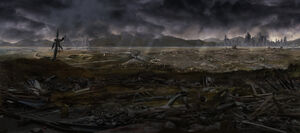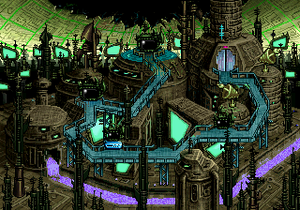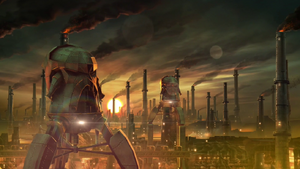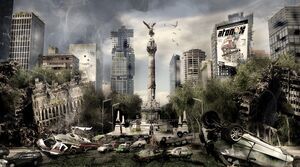
Dystopia
| “ | As the sound of the playgrounds faded, the despair set in. Very odd what happens in a world without children's voices. I was there at the end. | „ |
| ~ Miriam describing the dystopian planet Earth in the year 2027 A.D. since it was ravaged by 18 years of global human infertility. |
A Dystopia refers to a fictional or theoretical world in which the standard of living has become so bad that it is often nightmarish - it is the exact opposite of a Utopia and has been used in numerous works of fiction with media such as "Big Brother" and "Animal Farm" being amongst the most well-known.
A Dystopia may resemble a Utopia at first (known as a "False Utopia") or may show little or no sign of hiding its true nature - in fantasy it is common for Dark Lords to proudly display their kingdom or empire as a dark and horrific realm, while other dictators try to disguise their cruelty with the use of grand statues or seemingly benevolent acts that hide the true horrors at hand.
Dystopias are most often seen as dictatorships but they can also be anarchy in which gangs and whatnot rule supreme (as popularized in Mad Max).
Variants of Dystopia can even have non-human antagonists (such as Planet of the Apes) though this may overlap somewhat with the Alien Invasion scenario.
It might be noted that the term "dystopia", according to a strict definition, implies a fictional setting and precludes any possibility of real life examples. This is not, however, to suggest there is not a certain amount of truth in television to compare with fictional examples- for example, North Korea is sometimes compared to Nineteen Eighty-Four, which in itself was based on the various Real Life totalitarian regimes that were around at the time of writing.
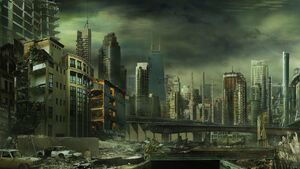
The Crapsack World
The Crapsack World is a term, which is part of the Dystopia trope, used to describe such particularly brutal and/or more dark place to live. In general, a Crapsack World is a type of Dystopia that offers little to no hope for the characters involved and embodies the nature of their setting; such worlds tend to be Hell on Earth, and can vary, depending on the creator, from comedic yet violent (such as, arguably, South Park) to outright sadistic and without hope (as shown in the lore of the popular videogame franchise Warhammer and the comic book canon of Judge Dredd). This terrible setting is where the jaded notion of "anything that can go wrong will go horribly wrong" almost always applies, and it corrupts its inhabitants into perpetuating that nastiness against each other. More succinctly, trying to survive in one of these places will not work out well at all.
Although there are countless ways Crapsack Worlds can be depicted, it is usually dark, on the Romantic end on the "Romanticism Versus Enlightenment" scale, and on the cynical end of the "Sliding Scale of Idealism vs. Cynicism", so it will have either Grey and Gray Morality or Black and Gray Morality, if not outright Evil Versus Evil in the worst of cases (beware of Darkness-Induced Audience Apathy if one decides to go this route though). Settings like these are not kind at all to idealists, who usually get traumatized and/or die horribly when their attempts to change the world through idealism meet tragic ends.
Heroes in this setting are usually anti-heroes, and often have at least a bit of the Deadpan Snarker about them. Being good will suck, and if there are genuinely good heroes in this setting, expect them to be knights in not-so shining armor and/or hurting heroes—more idealistic heroes such as the Knight in Shining Armor tend to not last long in this kind of setting. Any victories they manage to win over the forces of this world are likely to be pyrrhic in nature.
Villains tend to run the gamut from sympathetic anti-villains (on any level of the "Sliding Scale of Anti-Villains") right down to the most horrific monsters to grace any kind of media. Truly awful villains are especially common in these kinds of settings, both to represent the misery of the setting in general and to give the anti-hero(ine) someone to whom he can look good in comparison. In truly extreme cases, even the most popular or powerful of these monsters suffer just as badly as everyone else. And Anyone Can Die.
Examples
The following is a list of universes and franchises that can be classified as "Crapsack Worlds".
Literature
- Cthulhu Mythos: The whole concept of Lovecraft's original work was that the universe had no meaning and humans were pretty much puppets to unimaginable forces that could destroy them at any given point, not out of malice but simply due to the alien nature of said forces. Lovecraftian horror is all about utter despair, hopelessness, and the inability of man to overcome the darkness all around him.
Comic Books
- Watchmen: Although superheroes exist in this setting, it rivals (perhaps even surpasses) a lot of Batman settings in terms of brutality and general pessimism (though, again, the presence of superheroes shows there is at least some hope left in the otherwise pitiless environment).
- Judge Dredd: The original version of Dredd's universe was a world ruled by Judges as corrupt and dangerous as the criminals they faced off against, with little to no freedom whatsoever.
Live-Action
- Godzilla: The Godzilla universe is the large place where giant monsters called Kaiju exist in the human world through fear and chaos that they wrought upon. The other examples of this are the aliens that have the ability to disguise themselves as human beings, machines and robots then destroy buildings and steal science experiments for world domination, monsters that can destroy the entire planets and many frightening scenes.
- Robocop: The reality of the Robocop franchise is arguably a fusion between a Crapsack World and a Gang World in the sense it has the anarchy and loss of control a Gang World, yet has a Crapsack World element in the fact the few who do value law and order are often manipulated by corrupt corporations.
Cartoons
- The Simpsons: The popular adult cartoon show The Simpsons plays the idea to the extreme; just like Family Guy, it become quasi-dystopian since Season 10. Homer chokes his son Bart in nearly every other episode while neglecting the kids in general or brushing off whatever Marge says to him. Lisa is the only sane girl of the whole town of Springfield, but even she gets caught up in whatever schemes the rest of her family gets into due to peer pressure. Bart is a mischievous youngster who does literally anything to get out of going to school or doing homework, and nearly every shenanigans he pulls is always done for a quick giggle no matter who gets hurt. Marge is the voice of reason unless the plot demands she does something out of the ordinary. And then there's Maggie, a baby who does a better job looking after herself than her family does.
- The whole town of Springfield in general is so full of Crapsack than it is the norm. The school is always dangerously underfunded while its staff pretty much barely pretends to care about its students. The police are nothing but a group of morons that hardly catch any criminals or they always go after people for very minor infractions, such as littering. The local tavern owner, Moe, not only allows people to get drunk in his bar, but encourages it, even though in real life a bar can lose its liquor license if people leave drunk. The mayor is so heavily corrupted that people don't even bat an eye at it, and when the town does get angry over it, they quickly forget about it. Even the nuclear power plant practically has zero safety for its employees and the town itself due to the corruption of the multi-billionaire owner. When it comes to the town itself as a whole, everyone has taken pride in every negative light they get thrown into, such as being the most depressing town in the country, the most polluted, and the most obese.
- The heavily toxic environment is a plot point in one episode when the character Frank Grimes is introduced as an average man who works from dusk to dawn everyday, lives in a small apartment next to a bowling alley, has a lousy car, and has to make do with sub-par meals for dinner. Frank is heavily appalled by Homer's lifestyle being so much better than his own by having better pay (in comparison to Frank's pay), a nicer car, a big house, and big tasty dinners. Frank eventually snaps from it all when he sees everyone are blissfully oblivious of Homer's idiocy and winds up killing himself by accident from the sheer madness. The writers stated they created the Frank Grimes character to show that a "normal" person could not survive in a place like Springfield. Although generally this is discussed among fans, as many see him as a Jerk Ass with a short temper.
- And there episode "Boys of Bummer" of textbook version of the idea with every last citizen (the town's sans Marge Simpson) driving Bart to suicide over a lost baseball game. This episode proves that Springfield can be as bad a place as South Park seen the above. It is safe to say that while the show plays the trope for laughs, it is also dark on a deeper level.
- South Park: The comedic world of South Park is full of dystopian themes, the town itself being regularly terrorized by all manner of ungodly horrors.
- Family Guy:The Family Guy (multi)verse, even alongside the realities of the said comedic adult cartoon franchise's popular spin-offs American Dad! and The Cleveland Show, has become quasi-dystopia in later seasons and used only as very dark and very black comedy. Quahog's folk are each a moron, a pervert, a jerk, mentally ill, or some combination of the above. And the Griffin family's friends and other family members are more badder; Lois's sister Carol was married to the corrupt and insane mayor Adam West who has gotten away with killing people in public, and the ever-pervy lady-chasing Quagmire is allowed to walk the streets and live like a normal person (presumably because he has an amusing catchphrase: "Giggity giggity goo!") (unofficially) alongside the extremely flamboyantly inappropriate boy-loving Herbert the Pervert and his creepy withered old pet dog Jesse.
- Robot Chicken: The entire premise of this show is to twist popular media into nightmarish, disturbing, or offensive parodies; many of its inhabitants are incredibly stupid, violent, or ignorant to boot.
- The Grim Adventures of Billy and Mandy: The world that Billy and Mandy reside in is pretty much a "kid-friendly" version of a Crapsack World, where almost everything is either out to kill you or plotting something even worse.
- Invader Zim: Zim's world is one where almost all of its inhabitants are either idiotic, evil, or both, and the few who are never are ostracized by the rest. There are never any truly happy endings for anyone.
Anime/Manga
- Berserk: The world of Berserk epitomizes this term; a medieval Europe-inspired fantasy world filled with warmongering countries, corrupt nobility, the demonic God Hand and their equally demonic Apostles. The humans are little more than the demons' playthings and the demons are doomed to go to Hell after they die. The horrific setting can also be justified; God itself was created as a result of humans subconsciously wishing for a cause to their misery, and has been that cause ever since.
- Street Fighter: At least in the animated movies, where rampant violence and disregard for life is extremely common; perhaps countered somewhat by the fact that heroes in this setting fight against this trend. Still, for the average man or woman on the street, life is suggested to be extremely cheap, dangerous, and violent, with people willing to brutally beat you for even the most minor of offenses.
- Batman: Some versions of Batman go under this archetype, especially settings such as Arkham Asylum/Arkham City were even victory for Batman seems bittersweet at best.
Videogames
- Warhammer: Both the Fantasy and 40K versions of Warhammer are worlds in which suffering, death, and hopelessness prevail, though there are genuine acts of heroism they tend to be ultimately in vain.
- Carmaggedon: This incredibly violent videogame is set in a world where almost everyone is a mass-murdering psychopath and the main form of entertainment is a brutal death-sport geared towards furthering this anarchic dystopia.
Gallery
NOTE: The limit is for 20 pictures only
Trivia
- Though several earlier usages are known, dystopia was deployed as an antonym for Utopia by J. S. Mill in one of his Parliamentary Speeches 1868 (Hansard Commons) by adding the prefix "dys" (Ancient Greek: δυσ- "bad"), reinterpreting the initial U as the prefix "eu" (Ancient Greek: ευ- "good") instead of "ou" (Ancient Greek: οὐ "not"). It was used to denounce the government's Irish land policy: "It is, perhaps, too complimentary to call them Utopians, they ought rather to be called dys-topians, or caco-topians. What is commonly called Utopian is something too good to be practicable; but what they appear to favor is too bad to be practicable." Decades before the first documented use of the word "dystopia" was "cacotopia" (using Ancient Greek: κακόs, "bad, wicked") originally proposed in 1818 by Jeremy Bentham: "As a match for utopia (or the imagined seat of the best government) suppose a cacotopia (or the imagined seat of the worst government) discovered and described."[10] Though dystopia became the most popular term, cacotopia finds occasional use, for example by Anthony Burgess, author of A Clockwork Orange, who said it was a better fit for Orwell's Nineteen Eighty-Four because "it sounds worse than dystopia". Some scholars, such as Gregory Claeys and Lyman Tower Sargent, make certain distinctions between typical synonyms of dystopias. For example, Claeys and Sargent define literary dystopias as societies imagined as substantially worse than the contemporaneous society in which the author writes, whereas anti-utopias function as criticisms of attempts to implement various concepts of utopia.


